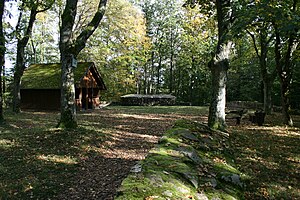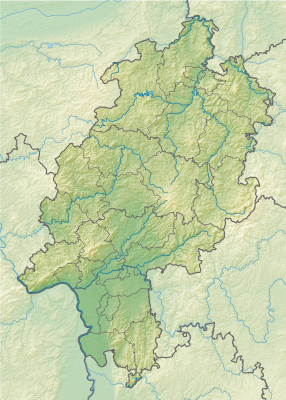Schnellerts Castle
| Schnellerts Castle | ||
|---|---|---|
|
View from the gate building to the main tower, on the left the modern refuge |
||
| Alternative name (s): | snelharts | |
| Creation time : | Beginning of the 13th century | |
| Castle type : | Hilltop castle | |
| Conservation status: | Wall remains (preserved curtain wall and tower stump) |
|
| Standing position : | unknown | |
| Construction: | Stone, half-timbered houses | |
| Place: | Brensbach | |
| Geographical location | 49 ° 44 '27.2 " N , 8 ° 53' 42.4" E | |
| Height: | 350.2 m above sea level NN | |
|
|
||
The castle Schnellerts is the ruins of a hilltop castle above the hamlet Stiersbach in the municipality Brensbach district Affhöllerbach in Odenwaldkreis in Hesse .
location
The ruin stands on a wooded hilltop 350.20 m above sea level, the so-called and eponymous Schnellerts or Schnellertsberg in the northern Odenwald . This summit marks the end of a ridge facing northwest towards the Gersprenztal , which, including the castle and the hamlet of Stierbach, forms the southern border of the Affhöllerbach district towards Ober-Kainsbach . Ober-Kainsbach is a district of Reichelsheim .
From the wooded today hilltop existed until 1900 a good view of the valley of Gersprenz and two side valleys, especially on the non for former parish and centering court Kirchbrombach belonging Nieder-Kainsbach and Frankish-Crumbach .
history
There is no documentary evidence of the legendary Schnellert Castle in the Odenwald . Its history emerges from archaeological excavations of the 20th century and from the research history of Schnellert since the 18th century.
The monument topography of the Odenwaldkreis, published in 1998, locates the construction of the complex in the first half of the 13th century in the late Staufer era and names the Lords of Crumbach on Rodenstein as possible builders , who might have opposed the castle to the expansion efforts of the von Erbach taverns . A permanent Huss zu Kunspach mentioned in 1391 , at that time owned by Breuberg , is most likely to be equated with the castle above the Kainsbach.
According to more recent considerations, the complex could possibly be assigned to a ministerial family of Hochhausen or the Lords of Frankenstein who were occupied in the vicinity of the Counts of Erbach .
A brick and fire clay analysis of soil finds in the luminescence laboratory of the Curt Engelhorn Center for Archaeometry in the Klaus Tschira Laboratory for Physical Age Determination in Mannheim resulted in an estimate of the age of the construction and destruction of the half-timbered buildings that were built with the castle from around 1220 to 1330 with a deviation of + / - 90 years. The dating of the castle is based on age estimates for finds of stove-top tiles, remains of a bell , a Romanesque arch stone and for a high medieval stirrup . The castle was destroyed a little over 100 years after it was built. Finds such as a conspicuously large number of blideballs , arrowheads and crossbow bolts as well as traces of fire point to a violent end of the castle in the Middle Ages, probably shortly after 1300, as the Schnellerts research association believes, but perhaps only after the mention of 1391, as the authors of the monument topography believe.
The current name of the castle was first mentioned by the mountain in 1426 when a "snelharts meadow" was mentioned, and the actual castle name is not known.
In 1742 the ruin was first mentioned in the Reichenberg protocols of an Erbach bailiff. Further mentions in it continue until 1796. In 1745 it is said that “only a few Rutera can be seen” from the “ancient castle”. From 1747 the ruins belonged to the Counts of Erbach-Schönberg. In the minutes there is also a reference to the “ Schnellertsgeist ” that goes through the barns of the Haalhöfe . In 1756 the Schnellertswiese belonged to the Haalhof in the Kainsbachtal below the castle. The legend of the Rodensteiner connects the Schnellerts castle ruins with the nearby Rodenstein castle , as in the legend the Schnellertsherr moves through the air to the Rodenstein.
In the 19th century there were still large masses of stone from the ruins. In 1840 the first summer festival took place on the Schnellerts, for which the castle area was leveled. In 1886 the ruins on the Schnellerts were recognized as medieval by the Brensbach pastor's son Professor Eduard Anthes (1859–1922), antiquarian , archaeologist and route commissioner for the Imperial Limes Commission . Until then, the complex had been considered a Roman fortification . In 1891 the Ohly Tower was built as a wooden observation tower on the site of the ruin, but it was demolished again in 1906.
In 1971 and 1972 wild digs took place on the mountain. In 1975 the Schnellertsfreunde interest group was founded, from which on August 6, 1976 the Schnellerts e. V. emerged to carry out restoration work. A large part of the walls had been preserved and restored by 1990 .
Scientific excavations took place in 1991. The excavations have been since 1995 by Christof Krauskopf in the master's thesis : .... .... which only a few are said to have rutera to see published. In the old town hall, the Protestant parish hall next to the church in Brensbach , is the Schnellertsmuseum with finds from the excavation.
investment
Remnants of the irregular hexagonal ring wall have been preserved from the complex ; it was conserved on the existing foundation walls from 1976 to 1990. The polygon formed by the wall had a maximum diameter of 36.50 meters. In the east of the complex, attached to the curtain wall, there is a round tower stump with a diameter of about 6.50 meters, 2.10 meters thick walls and a dungeon with a diameter of 2.25, probably the main tower or keep of the complex. Its small interior allows the assumption that it served more as a guard and protection tower than as a residential tower .
The entrance to the castle was on the west side. Pronounced gate cheeks suggest that there was a half-timbered building above . Other castle buildings have left only minor traces in the earth. Two brick - covered half - timbered buildings on the north-north-west wall and a stable building in the north-east corner, which are not visible today, have been proven . A Romanesque garment stone from the 13th century was found from a massive stone building .
The surrounding ditch and berm are clearly visible on all sides . In the modern refuge, a former sheepfold in the north of the castle courtyard, there are display boards about the castle and the Böllsteiner Odenwald .
literature
- Thomas Biller: Castles and palaces in the Odenwald. A guide to history and architecture. Schnell and Steiner, Regensburg 2005, ISBN 3-7954-1711-2 , pp. 192–194.
- Georg Dascher, Norbert Harre, Christof Krauskopf: The castle on the Schnellerts in the Odenwald. Guide sheet to the castle ruins near Brensbach-Affhöllerbach above Stierbach in the Odenwald district. Archaeological monuments in Hessen 142, Wiesbaden 1998, ISBN 3-89822-142-3 .
- Christof Krauskopf: "... of which only a few rutera should be seen ..." excavations in the castle ruins of Schnellert . Bamberg 1995, ISBN 3-931278-00-X .
- Rudolf Knappe: Medieval castles in Hessen. 800 castles, castle ruins and fortifications. 3. Edition. Wartberg-Verlag, Gudensberg-Gleichen 2000, ISBN 3-86134-228-6 , pp. 555-556.
- Joachim Zeune : Modern Castle Research. In: J. Zeune: Castles - symbols of power. A new image of the medieval castle. Friedrich Pustet, Regensburg 1996, ISBN 3-7917-1501-1 , pp. 142f.
- Rolf Müller (Ed.): Palaces, castles, old walls. Published by the Hessendienst der Staatskanzlei, Wiesbaden 1990, ISBN 3-89214-017-0 , p. 62f.
- State Office for Monument Preservation Hessen (Ed.): Monument topography of the Federal Republic of Germany. Cultural monuments in Hessen. Odenwaldkreis. Wiesbaden 1998, p. 174f.
Individual evidence
- ↑ Thomas Steinmetz: Castle Freienstein and their Burgmannen. In: Contributions to the exploration of the Odenwald and its peripheral landscapes VI. Published by Winfried Wackerfuß on behalf of the Breuberg Association . Breuberg-Neustadt 1997, ISBN 3-922903-06-1 , p. 57, footnote 48.
- ↑ Thomas Steinmetz: A document on the early history of the Breuberg rule . In: Der Odenwald , Heft 1, 2000, pp. 3–12.
- ^ Dating of the castle on www.schnellerts.de , accessed on September 22, 2016
- ↑ http://www.schnellerts.de/index.php/die-burg-auf-dem-schnellerts/chronologie/
- ↑ Monument topography Odenwaldkreis 1998, p. 174.
Web links
- Schnellerts Castle, Odenwaldkreis. Historical local dictionary for Hessen. In: Landesgeschichtliches Informationssystem Hessen (LAGIS).
- State Office for Monument Preservation Hesse (ed.): Ruine Schnellerts In: DenkXweb, online edition of cultural monuments in Hesse
- Homepage of the Forschungsgemeinschaft Schnellerts eV with information about the history, legends and myths about the castle, a chronology, about the museum and current works
- 360 ° panorama of the ruin






